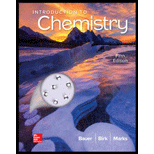
Concept explainers
When
Which of the other pH values could you obtain by diluting a
(a)
Interpretation:
The given statement that
Explanation of Solution
It is given that
It is known that,
Substitute
The
The
The
Now,
(b)
Interpretation:
The given statement that
Explanation of Solution
The
The
The given solution is already
(c)
Interpretation:
The given statement that
Explanation of Solution
The
The
Substitute
The solution needs to be diluted to
(d)
Interpretation:
The given statement that
Explanation of Solution
The
(e)
Interpretation:
The given statement that
Explanation of Solution
The
The
Substitute
The solution needs to be diluted to
Want to see more full solutions like this?
Chapter 13 Solutions
INTRODUCTION TO CHEMISTRY(LL)-W/CONNECT
 Chemistry & Chemical ReactivityChemistryISBN:9781337399074Author:John C. Kotz, Paul M. Treichel, John Townsend, David TreichelPublisher:Cengage Learning
Chemistry & Chemical ReactivityChemistryISBN:9781337399074Author:John C. Kotz, Paul M. Treichel, John Townsend, David TreichelPublisher:Cengage Learning Chemistry & Chemical ReactivityChemistryISBN:9781133949640Author:John C. Kotz, Paul M. Treichel, John Townsend, David TreichelPublisher:Cengage Learning
Chemistry & Chemical ReactivityChemistryISBN:9781133949640Author:John C. Kotz, Paul M. Treichel, John Townsend, David TreichelPublisher:Cengage Learning Chemistry: Principles and ReactionsChemistryISBN:9781305079373Author:William L. Masterton, Cecile N. HurleyPublisher:Cengage Learning
Chemistry: Principles and ReactionsChemistryISBN:9781305079373Author:William L. Masterton, Cecile N. HurleyPublisher:Cengage Learning ChemistryChemistryISBN:9781305957404Author:Steven S. Zumdahl, Susan A. Zumdahl, Donald J. DeCostePublisher:Cengage Learning
ChemistryChemistryISBN:9781305957404Author:Steven S. Zumdahl, Susan A. Zumdahl, Donald J. DeCostePublisher:Cengage Learning Chemistry: An Atoms First ApproachChemistryISBN:9781305079243Author:Steven S. Zumdahl, Susan A. ZumdahlPublisher:Cengage Learning
Chemistry: An Atoms First ApproachChemistryISBN:9781305079243Author:Steven S. Zumdahl, Susan A. ZumdahlPublisher:Cengage Learning





